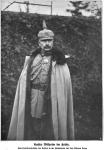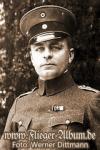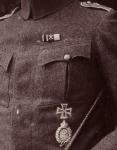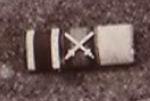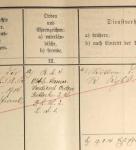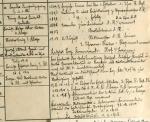-
Posts
4,908 -
Joined
-
Last visited
-
Days Won
97
Content Type
Profiles
Forums
Blogs
Gallery
Events
Store
Everything posted by Dave Danner
-
A little late, but some additional information: Achill Arthur Hermann Wilhelm Friedrich von Oertzen, was born on 12 June 1872 in Hamburg. He was married on 23 October 1909 to Ilse Karoline Luise Julie Erdmuthe von Kottwitz (7 June 1884). Achill was promoted to Major on 28 November 1914. His MMV2 was gazetted on 8 March 1915, although the actual award date was probably a little earlier. His brother, Max Wilhelm Konrad von Oertzen, was born on 20 November 1877. In 1914 he was a Rittmeister and Adjutant of the 9. Kavallerie-Brigade. He is erroneously listed in Wegner's Stellenbesetzung der deutschen Heere 1915 bis 1939 as having commanded Kürassier-Regiment Nr. 4 at the end of the war. However, that was another Max, Maximilian Eduard Hugo von Oertzen, who in 1914 was a Major and Adjutant of the 3. Kavallerie-Inspektion. Achill's and Max's parents were Hermann Arthur Friedrich von Oertzen (9 Dec 1844 - 8 Mar 1906), a Prussian Major, and Ernestine Wilhelmine Gräfin von und zu Westerholt und Gysenberg (4 Dec 1849 - ?). Achill's nephew, Max's son Max-Friedrich von Oertzen, born 30 Oct 1909, was killed in action as a Hauptmann on 26 September 1942 near Voronezh. Max had another son, Joachim Ernst, born 23 June 1913, but I don't have any information on him. If Achill had any children, they were born after 1920. As Colin suspected, Achill and Hans-Ulrich von Oertzen were not closely related. Achill was part of the house of Bagentz. Hans-Ulrich was from the house of Teschow. Those two houses' common ancestor would have been back in the 1600s. And finally, Achill's uncle, Arwed Wilhelm von Oertzen (2 Aug 1843 - 3 Feb 1917), was commander of the 28. Division in 1898-1900. He was a Generalleutnant z.D. in 1914, but does not appear to have been recalled to active duty. Regards, Dave
-
Werner von Rohrscheidt was, as far as I can tell, the only Oberleutnant von Rohrscheidt in November 1917. Werner Friedrich Wilhelm von Rohrscheidt, born 11 June 1889, was at the beginning of the was a Leutnant in Husaren-Regt. Nr. 6. He had just before the war transferred to the reserve, but returned to the active officer corps in August 1914. He was promoted Oberleutnant on 28 December 1916 and the Ehrenrangliste shows him as a Rittmeister a.D. He wasn't an Oberleutnant in 1916, though. There was an Oberleutnant d.R. von Rohrscheidt in 1917 - Paul Dietrich von Rohrscheidt - but he was an Adjutant in 3. Garde-Feldart.-Regt. and the only award I have for him is an EK2. There was also Oberleutnant z.S Erik Henning von Rohrscheidt, but he was a submariner and the 1918 navy rank list shows him with just the EK1&2. Of the other von Rohrscheidts: 1. Manfred v.R., Werner's brother, was a Lt. in HR 6 for the entire war. Commissioned a Lt. in June 1914, he was retired from active service as a Lt. in the Ers.Esk. of HR 6 in May 1918. 2. Kurt Gerhard v.R. was a Lt. in GR 5, promoted OLt. on 22.3.18 3. Friedrich Georg Arno Kurt v.R. was an OLt. in JRzP 10 in the 1914 RL, but was promoted Rittmeister on 4 July 1914. He was killed on 20 October 1918 with RIR 222. 4. Hans Kaspar Amandus v.R. was a Saxon OLt.d.L. 2. Aufgeb. who doesn't appear to have any front-line service. 5. Ernst Konrad Horst v.R., a Lt. in IR 28, was killed in action on 3 May 1917 with RIR 25. 6. Paul Friedrich Robert Max v.R. was a char. Major in the Invaliden-Haus in Berlin. 7. Egon v.R., Hptm. in FR 34, promoted Maj. on 5 Oct. 1916. 8. Bernhard Eduard Walter v.R., Major on the Great General Staff 9. Dr.jur. Hans Fritz Rudolf v.R., Hptm.d.R., 3.GFAR, on 15 February 1915 10. Herbert Gunter v.R., in 1914 a Lt. in the Reit.-Feldjäg.-Kps., promoted OLt. on 8 Oct. 1914 and Hauptmann on 18 Dec. 1915. 11. Joachim Jürgen v.R., killed in action on 24 August 1914 with HR 3. 12. Bodo Gerhard v.R., died as a result of wounds on 4 August 1915 as a Fähnrich in FR 33. 13. Friedrich Wilhelm Hans v.R., Oberst a.D., recalled as Kreis-Chef in Belgium, promoted to Generalmajor z.D. on 30 March 1918. 14. Klaus Hans Gustav Karl v.R., promoted Lt. in IR 93 on 1 March 1915, died as a result of wounds on 11 April 1917 with RIR 263. There were also two von Rohrscheidts in Austro-Hungarian service. Ernst Alfred Friedrich was an Ökonomie-Offizier in Garn.-Hospital 1 and a Hptm.i.d.Ruhestand, and his brother Rudolf Alfred was a Gefangenen-Kontrollor and Hptm.i.d.Evidenz. For two family members I don't have any information. Hans-Ulrich, the younger brother of Werner and Manfred, born 12 March 1900, was probably a cadet or officer candidate when the war ended, but I can't be sure. Günther Theodor Konrad von Rohrscheidt, born on 24 Dec. 1888, seems old enough to have served, but doesn't appear to have.
-
OK, somewhat more detailed but also a bit of a guess, if Saxony had the same or similar rules as Bavaria: The Bavarian rank lists, unlike the Prussian and Saxon, do include the Centenary Medal. I reviewed the December 1897 Bavarian rank list and identified which officers received the medal. I also checked this against some later RLs and against the Kriegsranglisten where I could find the person. From what I can tell, Bavarian recipients fall into 4 categories: 1. Veterans of 1870/71 war. 2. Officers serving, even temporarily, in Prussian units, schools, etc. For example, Eduard Doehla and Anton Löhr (both later "Ritter von") received the Centenary Medal while at the Prussian Militär-Turnanstalt in 1897. Ludwig Seeger, then with the 5. bay. FAR, received the Centenary while assigned to the Prussian Artillerie-Prüfungs-Kommission. Karl von Nagel zu Aichberg got his while Adjutant of the IV.Armee-Inspektion. Luitpold Freiherr von Horn was commanded to the Great General Staff in Berlin. Maximilian Graf von Zech auf Neuhofen was a student at the Prussian Feldartillerie-Schießschule. 3. Active officers in certain units. In these units, it appears every officer was eligible. Surprisingly, they are not the units to which the Kaiser or a Prussian prince was Inhaber. Instead, they were the Bavarian units then in Alsace-Lorraine. They were: - 4. Inf.-Regt., Metz, part of the 10. Inf.-Brig. - 8. Inf.-Regt., Metz, part of the 10. Inf.-Brig. - 3. Chev.-Regt., Dieuze, part of the 5. Kav.-Brig. - 5. Chev.-Regt., Saargemünd, part of the 5. Kav.-Brig. - I. Btl./2. Fußart.-Regt., Metz - III. Btl./2. Fußart.-Regt., Metz Also, most of the officers of the II.Btl./23.bay.IR in Saargemünd also had the Centenary Medal. This battalion was formed in April 1897 from the 13. and 14. companies of the 4.bay.IR and of the 8.bay.IR. 4. Finally, a random assortment of about 40 other officers I can't account for. Many were reserve officers and might have had a civilian connection to Prussia. Some I just don't know. For instance, Friedrich Ritter von Bogendörfer was regimental adjutant of 6. Inf.-Regt. from 1895 to 1900. No other regular officers of his regiment got the Centenary Medal. Bogendörfer had previously received the Crown Order 4th Class in 1896. -- So, if Saxony followed similar rules, besides veterans of the Franco-Prussian War and officers serving in Prussian units, there were two Saxon units whose officers were probably all eligible. These were Inf.-Regt. Nr. 105, in Straßburg i.E. under the Prussian XV. Armeekorps, and Fußart.-Regt. Nr. 12, in Metz under the Prussian XVI. Armeekorps. Regards, Dave
-
I don't think that Brück received the medal because he was in FAR 28. Others in that regiment in 1897 don't have it. I can't be sure, but I think he received it because he was commanded to the Militär-Reit-Institut in Hannover at the time. The Saxon rank lists don't include the medal. The Königlich sächsische Militär-Verordnungsblatt for 1897 and 1898 has several decrees about the medal, but none identify specific units.
-
Moritz was the youngest son of General der Infanterie z.D. Karl Freiherr von Gall (1847-1926). Moritz had two older brothers who were officers: Karl Freiherr von Gall, born in 1877, was an Oberleutnant der Landwehr in 1914, promoted to Hauptmann 21 October 1914 while serving with the Hauptreserve Königsberg. Max Freiherr von Gall, born in 1879, was a Leutnant a.D. in 1914, promoted to Oberleutnant a.D. on 16 October 1914 and according to the Ehrenrangliste later a Hauptmann a.D. having served in RIR 224. A first cousin once removed, Waldemar Freiherr von Gall, was too young for World War I but served in World War II, commanding Grenadier-Regiment 697 on the Russian Front (German Cross in Gold on 2 September 1943) and Grenadier-Regiment 957 during the Battle of the Bulge. He was promoted Oberst on 1 April 1943 and ended the war at that rank. Another Freiherr von Gall, Sigfrid, who served in the Kriegsministerium, was only distantly related.
-
It was pure luck. Freiherr von Gall had the good fortune to serve on a Bavarian staff. I happened across his Kriegsrangliste entry. One of my many projects of late has been digging up non-Bavarians hidden away in the Bavarian wartime rolls. I don't know what his internet access is like, but I hope someone can let Rick know I found his guy.
-

EK 1914 The simple WW1 EK2...
Dave Danner replied to Chris Boonzaier's topic in Germany: All Eras: The Iron Cross
-
The Hauptmann with the HOH3X was Walter Rosencrantz. Erich might be the other. Walter was born on 19 March 1888. Besides the HOH3X, he had the EK1&2 and the BMV4X. As for Moritz Freiherr von Gall... Moritz Freiherr von Gall born 10.01.1882; 1914 OLt im IR 160, kdrt. z. Kriegsakademie; Hptm. 08.10.14 EK2 (14.09.14) EK1 (18.09.14) HOH3X (06.01.18) HT (13.11.14) GSF3aX (21.03.18) EH3aX (25.12.17) BMV4X (03.03.16) SA3aX (18.02.16) WF3aX (28.12.16) OFAK2 (04.07.16) REKj3XKr (08.04.18) ÖM3K (22.11.15) TH (01.07.16) :beer:
-
Awarded on 31 July 1917 I went through the MWBs and no other candidates jumped out, but I might have missed some. Two from IR 97 were promoted to Olt.d.R. in 1915, one from Gießen on 22.3.15 and another from I Darmstadt on 14.7.15, but I couldn't find any promotion to Hauptmann. Also, the second one, with the Darmstadt reporting station, doesn't seem to be in the 1914 rank list, unless he transferred from another regiment (I didn't see any further mentions of the Reiß in the reserve of IR 41, while the Reiß in IR 47 was apparently still a Lt.d.R. in February 1916 when he received the Bavarian Military Merit Order).
-
I recently provided some updated information on an aviator, Hans-Nikolaus von Beguelin, to the person who runs the www.Flieger-Album.de website, and he kindly sent me a larger scan of the picture of Beguelin he has from Werner Dittmann's wartime album. Here is a headshot from the biography page: Here is the larger scan of the chest: Here is my blow-up of the Feldspange: Hans-Nikolaus Gaston Konstantin von Beguelin was one of three brothers, all sons of Oberst z.D. Gaston Nikolaus Franz Adalbert von Beguelin, who commanded Landw.-Inf.-Regt. Nr. 52 during the war. All three brothers served in 3. Hannov. Inf.-Regt. Nr. 79, but Hans-Nikolaus was sent to the Fliegertruppe. The middle brother, Joachim Ernst Eugen, was killed in action on 22 August 1914. The younger brother, Konstantin Friedrich Wilhelm, left the army as a Lt.a.D., but returned in the 1930s. He served in the Wehrmacht-Versorgungs-Abteilung of the OKW and was promoted to Oberst in 1942. Hans-Nikolaus also returned to duty in World War II; a thread on the Axis History Forum has him as a Luftwaffe Oberstleutnant commanding an airbase in Lemberg (Lvov/L'viv) in 1943. But back to the pictures. The Feldspange shows three decorations. The Iron Cross is first, of course. Last is the Prussian Crown Order 4th Class which Beguelin received in March 1913 (an unusual award, since he was only a 23-year old Leutnant at the time). But what about the middle ribbon? Based on the pattern and what we know about color shifts on these old black&white photos, my best guess is the Princely Reuss Honor Cross with Swords. However, we don't have any rolls for Reuss, so there's no way to confirm. The Beguelins were Briefadel originally from Switzerland, and IR 79 was a Hannoverian regiment, so there's no direct connection to Reuss or any other German state. Does anyone else have any thoughts?
-
In looking at the rank lists of the various Train-Abteilungen, I see that the officers just below Major are all Rittmeisters. I assume some cavalry connection/heritage. Under what circumstances would or could a Rittmeister switch to Hauptmann? I ask because in the Schwarzburg rolls there is an award to a Hptm.d.R. Hermann Reiß, 1.Ordonnanz-Offizier, 103. Inf.-Div. The likeliest candidate for this to be from the 1914 rank list is Oberlt.d.R. Reiß from Train-Abteilung 18 (II Frankfurt am Main). He was promoted to Rittmeister d.R. on 27 January 1915, and was at the time with the Munitions-Kolonnen und Trains, XVIII.R.K.. I'm pretty sure he's the right Reiß because XVIII.R.K. controlled the 25.Res.-Div., which provided units including RIR 116 to form the 103.ID. He seems to be the only Reiß with the right rank and a possible connection to the 103.ID. But again, he was a Rittmeister. I've seen a Rittmeister become a Hauptmann i.G. when assigned to the General Staff. Would that happen for a division Ordonnanz-Offizier, too?
-
This isn't the kind of thing typically reported in the MWB at the time. The only aircraft crash mentions I find in the first half of 1918 are in articles on enemy planes being downed. I didn't see anything in the Zeitschrift für Flugtechnik und Motorluftschiffahrt either. You might have better luck with Deutsche Luftfahrt. Unfortunately, I am missing the volumes of the magazine for 1917 and 1918.
-
Another interesting one. Jakob Häring, born 14 April 1896 in Berg ob. Landshut. He got a Prussian Red Cross Medal 3rd Class on 28 July 1915 (the date was in his Stammrolle entry). In the summer of 1916 he was put in for an Iron Cross and a Bavarian Military Merit Cross, but got neither. A second Iron Cross recommendation in September was approved in November. A year later, he was put in for the Iron Cross 1st Class and a Bavarian Military Merit Medal (Bravery Medal). Nothing happened with the Bravery Medal. However, he did get promoted to überzähliger Gefreiter (supernumerary lance corporal), maybe in lieu of the medal. In December, he was made a statutory Gefreiter. It took a year for his Iron Cross 1st Class to get approved. By then, in April 1918, he was in the hospital (Res.-Feldlazarett 31). According to the Stammrolle, he was hospitalized from 28 February to 9 May 1918 for wounds from a mortar round. The entry said he was wounded in the back by shell fragments, and maybe someone thought that didn't sound great, so they added that he was wounded while transporting the wounded. So to the Iron Crosses and Red Cross Medal below, he added a black Wound Badge on 13 June 1918.
-
Another example: Pion. Ernst Gellrich, also from San.-Kraftw.-Abt. 6. Like Bolzau above, he was nominated for a "Lippe medal" on 6 June 1915 and received the Lippe Military Merit Medal with Swords on 30 August. Again like Bolzau, he was in the meantime nominated for a "Lippe cross" on 15 July and received it on 13 September. On Gellrich's record, we see the notation "anstelle der Medaille" ("in place of the medal"). His regular Kriegsstammrolle entry also notes that the War Merit Cross was awarded in place of the Military Merit Medal. For the next three years that is all he had. His Iron Cross 2nd Class didn't come until June 1918, and his long service medal in August 1918.
-
Feldwebel und Beamten-Stellvetreter Walter Findt, born 10 February 1881 in Friedrichshafen, Württemberg. He served from September 1914 to February 1919 in the same unit, but the unit kept changing names. It was originally the 3. württ. San.-Kraftfw.-Kol., then the San.-Kraftfw.-Kol. 6, then Etappen-San.-Kraftfw.-Abt. 6, and finally bay. San.-Kraftfw.-Abt. 6. It was the ambulance unit for the 6th Army. Probably because it started out as a Württemberg unit, a lot of its records are kept in Württemberg format rather than Bavarian. During the entire period, the unit had the same commander, Oskar von Haidlen. Those who have Erhard Roth's volume on Bavarian military awards in World War I may find an award of the Military Merit Order 4th Class with Swords to a Kgl. Württ. Rittm.d.L. Oskar von Haidlen, and an award of the Military Merit Order 4th Class with Crown and Swords to Kgl. Bayer. Maj.d.L. Oskar von Haidlen. They are the same person. He was a native Württemberger, in fact a fairly prominent one: an Oberlandesgerichtsrat, Senatspräsident at the Kgl. Oberlandesgericht in Stuttgart, and Mitglied d. Staatsgerichtshof, etc. He formed the unit when the war began and led it throughout. Born in 1854, he was a Rittm.d.L.a.D. when the war began. He was made a char. Major by Württemberg in August 1915, and on 13 August 1917 became a Bavarian Major der Kraftfahr-Truppen des Beurlaubtenstandes. His Kriegsrangliste entry says King Ludwig III himself administered his oath. Needless to say, Maj. von Haidlen did not have the same problem getting his awards rejected. The only one he seems to have been turned down for is the "V.K.Kr." proposed on 11.9.17. I assume this is the Prussian Verdienstkreuz für Kriegshilfe. He ended up with the Iron Cross 1st and 2nd Class, the Württemberg Friedrichsorden Knight 1st Class with Swords, the Württemberg Charlottenkreuz, the Bavarian Military Merit Order 4th Class with Crown and Swords, the Lippe-Detmold War Merit Cross, and the Hamburg Hanseatic Cross, all to go with his prewar Württemberg Landwehr-DA and pinback Order of the Württemberg Crown.
-
An interesting illustration of the process for Lippe awards. The NCO below, a Lippe native, initial served in Res.-Inf.-Regt. Nr. 202, and later went to the 6. Armee ambulance detachment (San.-Kraftw.-Abt. 6). On 6 June 1915, he was nominated for a "Lippe decoration" (Lipp. Ausz.). For whatever reason (wounding, no Iron Cross nomination when the recommendation arrived in Lippe), he got the Lippe Military Merit Medal on 30 August 1915. In the meantime, in July 1915, he was nominated for an Iron Cross 2nd Class and a Lippe War Merit Cross. The Iron Cross was turned down, but the Lippe War Merit Cross came on 13 September. As you can see, the Military Merit Medal was then crossed off, as was supposed to be the case according to the Lippe regulations which weren't always followed. It then took three more recommendations before an Iron Cross 2nd Class was awarded on 5 May 1916. After he arrived at his Bavarian-run unit, it took two recommendations to add a Bavarian Military Merit Cross 2nd Class to his awards.
-
Apparently, for this guy, an Iron Cross 2nd Class and a Württemberg Silver Military Merit Medal came relatively quickly, but it took three years and eight nominations to get a Bavarian decoration, in this case a Military Merit Cross 2nd Class with Crown and Swords on the ribbon for war merit. First proposed on 30 December 1914, finally awarded on 16 January 1918.
-
I just came across another possible scenario which might broaden the search. While updating and editing the recipients of the Princely Schwarzburg Honor Cross, I came across a Bavarian officer, Valentin Geck, who received the SEK3X as an Olt.d.R. in the Bavarian 21. Inf.-Regt. The rolls from Schwarzburg-Sondershausen generally only give a name and unit, and only sometimes give a residence, usually when the recipient is not from a Thuringian unit. In Olt. Geck's case, his residence was listed as Arnstadt, the largest city in the principality. Going to the Bavarian Kriegsranglisten, I found Geck's record, which show that he was born in Zautendorf, Fürth, Bayern (Zautendorf is now a part of Cadolzburg, a suburb of Fürth). His Arnstadt connection? His civilian job is listed as Gymnasialoberlehrer in Arnstadt. Why is this relevant? He was an officer in 21.bay.IR, whose Inhaber was the Grand Duke of Mecklenburg-Schwerin. As a Bavarian officer, he received the BMV4X. As an officer in 21.bay.IR, he received the Mecklenburg-Schwerin MVK 2nd Class. And because of his Arnstadt connection, he received the SEK3X. The EK2 and the 1905 Bavarian Army Jubilee Medal round out his awards. So like our elusive Bavarian-Baden-Meiningen enlisted man, he got one award due to the Army he was in, one due to the regiment, and one due to his residence. But he wasn't born in Schwarzburg-Sondershausen, he just worked there. Having gone through all the Meiningen-born soldiers and not finding a match, now I have to think maybe Rick's guy wasn't born in Meiningen, but moved there at some point.
-
Finally, another Kriegsrangliste entry, showing the RAO4, LD1, PRLM and the Oldenburg order, only this time with swords. As you can see, the wartime BMV4X and EK2 aren't there, as this rank list entry was created before those awards were made. The awards are to Rittmeister der Reserve Robert Ludwig von Ranke of the 2. Schw. Reiter Regiment. I called this a "mini-mystery" because I don't think there's any doubt that his Oldenburg House Order was without swords. Among other things, he doesn't have the Oldenburg Friedrich August Cross. He also has no Oldenburg connection. The von Rankes to which he belonged were Bavarians and he only became "von Ranke" in 1893 when his father's personal nobility was made hereditary. And Rittm. von Ranke served with Bavarian units during the war. The mini-mystery is that his 1914 ranklist doesn't show the OV3b, and Ferry W. von Péter's list of non-Bavarian awards to Bavarians in World War I doesn't list it. My guess is that it was gazetted in 1914 after the ranklist was published, but not included in the Bavarian volume because v. Péter missed it. This may be because v. Péter's book was on awards to Bavarian military personnel, and Robert von Ranke probably received the award right around the time the war broke out for his civilian job. Until August 1914, he was a German consul and deputy general consul in London, and had to leave England pretty quickly. The second part of the mini-mystery is why someone added swords at some point and no one caught or corrected the error. Makes me wonder whether there are other similar errors. Also one bit of trivia: through his sister's marriage to an Englishman, Robert von Ranke is the uncle of Robert von Ranke Graves, also known as just Robert Graves, the author of I, Claudius. Regards, Dave
-
While going through various Bavarian records, I came across this entry: The awards are: a) Bavarian Landwehr DA I & II Prinz-Regent-Luitpold-Medaille Bavarian Military Merit Order 4th Class with Swords (BMV4X) b) Non-Bavarian Prussian Red Eagle Order IV. Class Knight II. Class of the Oldenburg House and Merit Order with Swords [with an erroneous IV. Class in there] Iron Cross II. Class


